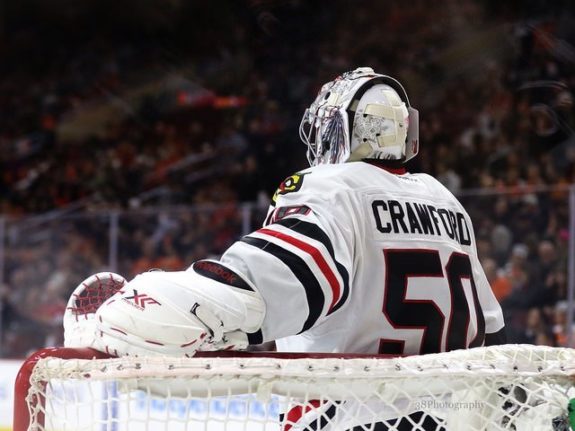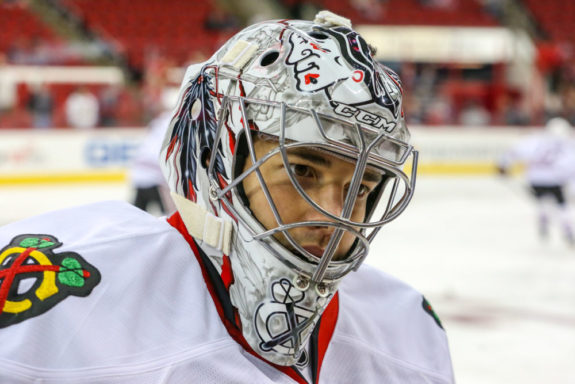Corey Crawford’s NHL career was largely overshadowed by the bright lights of Chicago Blackhawks superstars like Jonathan Toews, Patrick Kane, and Duncan Keith. But a deeper dive into Crawford’s performance reveals that he was consistently one of the best goaltenders of his era. Comparing his body of work to elite contemporaries like Henrik Lundqvist, Carey Price, and Jonathan Quick, it becomes clear that Crawford’s career holds up remarkably well.
Crawford’s Early Career and Breakthrough
Crawford, drafted 52nd overall by the Blackhawks in 2003, spent several seasons in the American Hockey League before finally becoming the team’s starting goaltender in the 2010-11 season. His 33-18-6 record, 2.30 goals-against average (GAA), and .917 save percentage (SV%) were impressive for a first-year starter.
Around this time, Lundqvist was already establishing himself as an elite goalie with the New York Rangers. Lundqvist, known for his technical precision and consistency, posted a 2.28 GAA and .923 SV% during the 2010-11 season. Although Lundqvist was a perennial Vezina Trophy contender, Crawford’s rookie numbers were comparable. While Lundqvist commanded the spotlight in New York, Crawford quietly matched his statistical output in Chicago, setting the stage for his eventual rise to elite status.
Crawford’s Ascension to Elite Status (2011-2015)
Crawford’s emergence as a top-tier goaltender became clear during the 2012-13 season. In a lockout-shortened campaign, he split regular-season duties with Ray Emery, but his postseason performance cemented his reputation. With a 1.84 GAA and a .932 SV% in 23 playoff games, Crawford was crucial in leading the Blackhawks to their second Stanley Cup in four years. His performance in the Final, especially in overtime, was clutch.

At the time, Price was coming into his own with the Montreal Canadiens. Price, who would eventually be recognized as one of the league’s best goalies, posted a .905 SV% during the 2012-13 season—numbers significantly lower than Crawford’s playoff brilliance. Price’s reputation grew, particularly with his 2014-15 Hart and Vezina Trophy-winning season, but Crawford’s consistent postseason heroics in the same timeframe put him on par with Price in terms of his impact on team success.
In 2013-14, Crawford again led Chicago to the playoffs with a 2.26 GAA and a .917 SV%. Quick, who was often compared to Crawford due to their similar playing styles and their team’s success, posted a 2.07 GAA and .915 save percentage that season. While Quick’s aggressive, athletic style earned him accolades, Crawford’s more reserved, positional play was just as effective. Both goaltenders were central to their teams’ success, but Crawford’s ability to stay calm under pressure became a defining trait as the Blackhawks made deep playoff runs season after season.
You may also like:
- NHL Morning Recap – January 20, 2026
- Blackhawks Week Ahead: Schedule & Storylines – Bedard Returns, Teräväinen Injury and More
- Jonathan Toews’ Return to Chicago Is About More Than One Night
- Key Takeaways From the Blackhawks’ 5-2 Loss to the Bruins
- NHL Morning Recap – January 18, 2026
Crawford’s peak came in 2014-15 when he led Chicago to another Stanley Cup with a 2.31 GAA and .924 SV% in the playoffs. His performance was comparable to Ben Bishop, who led the Tampa Bay Lightning in the same Final and posted a 2.18 GAA and .921 SV%. Despite Bishop’s brilliance, Crawford was the one who came out on top, further solidifying his reputation as a clutch playoff performer.
Crawford’s Continued Excellence and Later Years (2015-2020)
After his second Stanley Cup win, Crawford remained among the league’s elite. In the 2015-16 season, he recorded seven shutouts, finishing with a 2.37 GAA and a .924 SV%. For comparison, Braden Holtby, who won the Vezina Trophy that season, posted a 2.20 GAA and a .922 SV%. Holtby’s incredible season earned him much of the spotlight, but Crawford’s numbers were nearly identical, proving that he belonged in the conversation of top goaltenders.

Crawford’s resilience was further tested in the 2017-18 and 2018-19 seasons when concussions limited his playing time. Despite these setbacks, he still managed a .924 SV% in 2017-18, better than Sergei Bobrovsky’s .921 that same season. Bobrovsky, often lauded for his athleticism and ability to steal games, was regularly in the Vezina conversation, but Crawford’s ability to remain effective, even while battling injuries, showcased his mental toughness.
Crawford’s final season, 2019-20, was a testament to his ability to perform under pressure. Despite a pandemic-shortened season and health challenges, Crawford led the Blackhawks to an upset victory over the Edmonton Oilers in the Qualifying Round. His playoff GAA of 2.77 and .917 SV% were comparable to the Winnipeg Jets’ Connor Hellebuyck, who had a 2.57 GAA and .922 SV% in the same playoffs.
Comparing Crawford’s Legacy to Other Elite Goalies
While Crawford didn’t receive the same individual accolades as goaltenders like Lundqvist, Price, or Holtby, his stats and contributions are comparable, if not superior, in key areas. His career totals of 260 wins, a 2.45 GAA, and a .918 SV% stand shoulder to shoulder with Lundqvist (2.43 GAA, .918 SV%) and Quick (2.41 GAA, .913 SV%). Crawford’s two Stanley Cup victories and reputation as a clutch performer in the playoffs set him apart from many of his peers who, despite their accolades, didn’t enjoy the same level of postseason success.
What truly separates Crawford from many of the other elite goalies of his time is his consistency in delivering when the stakes were highest. While Price and Lundqvist were widely regarded as the best goalies during the regular season, Crawford consistently elevated his game in the playoffs, a trait that earned him two Stanley Cups and a reputation as one of the most clutch goaltenders of his generation. While he may have flown under the radar, Crawford’s career was exceptional.
